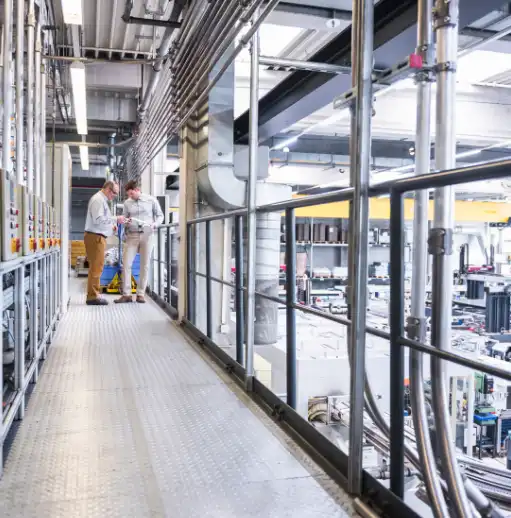
For building owners, property maintenance is a strategic investment that protects and enhances the value of real estate assets. Well-maintained properties can command higher rental rates and sale prices, directly impacting the bottom line. Property maintenance helps identify and address minor issues before they escalate into major problems, preventing unexpected downtime and reducing repair costs.
It also ensures compliance with safety regulations and building codes, mitigating legal risks. For large organizations with multiple facilities, it delivers significant value by maintaining the property’s condition, ensuring tenant satisfaction, and optimizing return on investment.
What is property maintenance?
Property maintenance is the proactive upkeep and care of a building or facility to ensure it remains in optimal condition, preserving its value and functionality, including:
- Regular inspections
- Preventive maintenance
- Repairs and replacements
- Capital projects and improvements
Regular maintenance extends the lifespan of assets and systems, such as HVAC, plumbing, and electrical infrastructure, delaying the need for costly replacements. It also enhances the property’s aesthetic appeal and safety, which is vital for tenant satisfaction and retention.
Property maintenance helps facility and maintenance teams identify and address minor issues before they escalate into major problems, preventing unexpected downtime and reducing repair costs. It also ensures compliance with safety regulations and building codes, mitigating legal risks. What activities does property maintenance cover?
The teams in charge of property maintenance are responsible for both the building itself and the surrounding grounds, including:
- Maintaining all assets and equipment, including plumbing, electrical, security and safety systems, and HVAC
- Landscaping
- Pest control and removal
- Cleaning all common areas, including lobbies, restrooms, and corridors
- Separating and removing recyclables and garbage
Generally, they are not responsible for the small repairs tenants are expected to take care of themselves. For example, in a residential building, the property maintenance team doesn’t replace burned-out light bulbs.
What are the benefits of property maintenance?
Property management ensures a well-maintained and safe living or working environment for occupants. Regular maintenance and prompt repairs address any issues that could impact comfort or safety, such as heating, cooling, or plumbing problems. Professional management also provides a clear channel for communication, allowing tenants to easily report concerns and receive timely responses.
Additionally, property managers often offer emergency services, providing peace of mind. They also handle lease agreements and renewals, offering guidance on legal rights and responsibilities. Moreover, property management can foster a sense of community by organizing events and facilitating neighborly interactions. This is just as true for offices as it is for residential units.
For building owners, property management offers significant advantages in terms of time, money, and legal compliance. Property managers handle day-to-day operations, freeing owners from tasks like tenant screening, rent collection, and maintenance coordination. They also bring expertise in marketing and leasing strategies to maximize occupancy rates and rental income.
Property management ensures compliance with housing regulations and codes, reducing legal risks. Furthermore, proactive maintenance and timely repairs protect the property’s value and minimize long-term expenses. Property managers also provide regular financial reporting, helping owners track income and expenses for informed decision-making.
How does facility management software help with property management?
Modern facility management software helps you schedule work, assign it to the right people, and then track what they’ve done. Because all your data is up to date, it’s also reliable, and that means you can use your data to generate reports packed with insights into your operations. Once you know where you’re spending your budget, you can control spending better.
Cloud computing
With traditional methods, you’re stuck doing everything on paper or spreadsheets. Both are terrible, but in different ways.
With paper, it’s hard to generate data but also easy to lose it. Every work order has to be written out by hand, giving you plenty of chances to copy over the wrong information or accidentally skip adding a critical detail. And once you have your one work order, that’s all you have: one work order. After chasing down a maintenance tech or getting one to come all the way back to your office, you hand over the one and only copy you have. Now it’s their turn to run the real risk of misplacing it.
With spreadsheets, it’s easy to generate data but hard to keep it up to date. Because all you need to do to generate a new copy is copy and paste, you can quickly generate and send out many copies of the same work order.
But they don’t remain copies for long. Instead, they quickly turn into versions. What’s the difference? Copies are identical, just like identical twins right after they’re born. Versions are those same twins but twenty years later. They’ve lived their own lives, and now they’re different. They might sort of look the same, but they’re not.
The problem for you is that you don’t know which one to trust. When a tech makes a change on one spreadsheet, nothing carries over to all the other spreadsheets out there with the same file name. Your version says one thing and the tech’s version says something different.
Modern cloud computing solves all these problems with a central database that lives in the cloud. Now your data is safe, secure, searchable, and accessible from anywhere. And because everyone is working from the same data set, everything is always up to date.
Building from centralized data, the software can then deliver a lot of features that help you strengthen and streamline your maintenance operations.
Open request portal
With manual methods, tenants have to waste time tracking down phone numbers and email addresses. Even if they knew where the maintenance office was, they’d have to take the time to walk over, hoping to catch someone between word orders.
And for all the time it took them to submit the request, it wasn’t likely helpful anyway. Because they wouldn’t know what information maintenance needed, they’d likely accidentally skip important details. A complaint about a leaking pipe might not include the pipe’s location or how bad the leak was.

Modern facility management software includes an open request portal that people can quickly access online to submit maintenance requests. Once the maintenance team has the request, they can use the software to review and approve it, then generate, prioritize, assign, and track a new on-demand work order.
Data-packed work orders
With a modern system, the team can generate work order packed with everything techs need to work efficiently and close out quickly, including:
- Comprehensive asset maintenance and repairs histories
- Step-by-step instructions
- Customizable checklists
- Associated parts and materials
- Digital copies of images, schematics, and warranties
- Interactive site maps and floor plans
Now when a tenant says that there’s a leak in the ceiling in the underground parking garage, the tech arrives onsite knowing exactly what work they need to do and how they need to do it. They have all the parts and materials already on them.
As soon as the maintenance or facility manager generated and assigned the work order through the software, the tech received a notification on their maintenance app. From there, they can access the work order.
Scheduled and tracked PMs
Preventive maintenance in property management is invaluable for its proactive approach to preserving asset value and ensuring operational efficiency. By scheduling regular inspections and routine upkeep, property managers can identify and address potential issues before they become major problems.
For example, consider the HVAC system in a commercial building. Regular preventive maintenance, such as filter changes, coil cleaning, and system checks, can extend the lifespan of the equipment and maintain optimal performance. A proactive approach prevents unexpected breakdowns, which could lead to uncomfortable indoor temperatures, tenant complaints, and even temporary business closures. Moreover, a well-maintained HVAC system operates more efficiently, reducing energy consumption and lowering utility costs.
Leveraging the preventive maintenance features, maintenance professionals can set up and schedule inspections and tasks (PMs) packed with instructions, checklists, and associated parts.
Robust reports
Reports can deliver a comprehensive overview of maintenance activities, costs, and trends, enabling teams to identify patterns, track performance, and optimize resources.
For example, the maintenance team managing a portfolio of apartment buildings, by leveraging data from monthly maintenance reports, might discover a recurring issue with water leaks in specific units, leading to high plumbing repair costs and tenant inconvenience. By further analyzing the reports, they see that these units shared a common installation date for their plumbing fixtures.
Armed with this insight, they proactively replace the aging fixtures in all units from that installation period, rather than waiting for individual failures. The strategic approach reduces the overall number of service calls, minimizes water damage and repair expenses, and improves tenant satisfaction.

Reports empower maintenance teams to shift from reactive to proactive management, enabling them to anticipate issues, allocate resources effectively, and ultimately enhance the property’s overall condition and value.
Leveraging BIM data for property management
In modern property management, building information modeling (BIM) data can play an important role in streamlining operations, enhancing efficiency, and reducing costs. By integrating BIM data into different workflows, facility managers and building owners can gain a comprehensive understanding of their assets, enabling better decision-making and proactive maintenance.
BIM data provides a detailed, three-dimensional digital representation of a building, including its structural, mechanical, electrical, and plumbing systems, which can be used to create a digital twin — a virtual replica of the physical building. Digital twins are not just static models.
They are dynamic, real-time simulations that can be updated with live data from sensors and other Internet of Things (IoT) devices, empowering facility managers to monitor the building’s performance, identify potential issues, and optimize operations in real-time.
One of the many advantages of using BIM data in facility management is the ability to perform predictive maintenance. By analyzing the data from the digital twin, managers can anticipate equipment failures and schedule maintenance before problems occur.
A proactive approach reduces downtime, extends the lifespan of assets, and minimizes unexpected repair costs. Facility and maintenance teams can also use BIM data to simulate various scenarios, such as energy consumption patterns or the impact of renovations, helping managers make informed decisions that improve the building’s overall efficiency and sustainability.
They can also use BIM data to ensure compliance with safety regulations and building codes. By maintaining an accurate digital record of the building’s systems and components, managers can easily track maintenance history, identify areas that require attention, and generate reports for regulatory bodies. This not only simplifies the compliance process but also mitigates legal risks.
The value of modern property maintenance
Both tenants and owners want properties that are safe, comfortable, and functional. Modern property maintenance software helps streamline operations and operations by moving all data to the cloud, where it’s both safe and accessible. Once everyone is working from the same data, there’s less lag, fewer mistakes, and more opportunities to turn raw data into actionable insights.








